The Five Key Players That Forged the Corvette
by K. Scott Teeters
Corvette Illustrations Courtesy of Artist, K. Scott Teeters
I was just a little kid when I discovered the world of Corvettes one day at Haddonfield Chevrolet, in Haddonfield, NJ. I was with my big brother Bob and he had just purchased a beautiful ‘57 Chevy 2-door Coupe. There wasn’t anything hot about the car, it was just a NICE ‘57 Chevy. While I was waiting for Bob to have a minor repair completed in the Service Department, I spotted the coolest car I’d ever seen.
On the showroom floor was a ‘65 Corvette coupe. The sales guy could tell that I obviously LIKED the car, so he said, “Here kid! Have a brochure.” And that’s how it started for me. After that, I started buying AMT model car kits and studying the instruction sheets because they had wonderful exploded-view technical drawings with callouts, so you knew the parts you were trying not to get too much airplane glue onto.
I also discovered car magazines and bought anything that had articles or pictures of Corvettes. Sometimes in an article on a Corvette, I would see pictures of a white-haired man that looked not unlike my grandfather – only happier. And he had a funny name, “Zora Arkus-Duntov.”
As the years rolled on and I read and learned more about Corvettes and Mr. Duntov, he was elevated to hero status for me, right up there with Don Garlits, Grumpy Jenkins, Jungle Jim Liberman, and Jim Hall,the popular race car builders and drivers of the sixties and seventies. When I was about 12-years-old, I wrote a letter to Mr.. Duntov. I don’t recall what I wrote, but a few months later I got an envelope from Chevrolet. It wasn’t a letter from Mr. Duntov, but it had several issues of Corvette News and a nice letter from their marketing department thanking me for my note to Mr. Duntov. They thought I might like the issues of Corvette News. The magazine was ONLY available to Corvette owners and you got a subscription with the purchase of the car. How cool is that!?! And, to top it off, they put my name on the mailing list and for a few years I got “Corvette News” and I didn’t even have a driver’s license!
I figured out long ago that were it not for Duntov, the Corvette would have been tossed into the trash heap of failed cars like the Corvair and Vega. As I look back into the Corvette’s early days, I see five key players in which the absence of any one of the five, would have doomed the car. Here are my pick for the five key players that forged the Corvette.
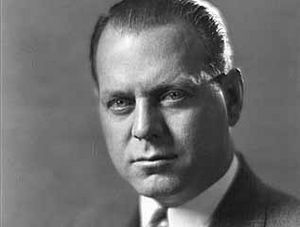 Caption: Almost every picture I’ve ever seen of Harley Earl, he looks very stern. I was surprised to learn that he had a rather high, squeaky voice.
Caption: Almost every picture I’ve ever seen of Harley Earl, he looks very stern. I was surprised to learn that he had a rather high, squeaky voice.
1. Harley Earl – the “creator” of the Corvette concept. Earl was slightly ahead of the trend in the early ‘50s when GIs returning from military service in occupied post WWII Europe came home with a new kind of bug – the “sports car” bug! American cars were for the most part, big, lumbering machines.
The lightweight little sports cars of the late ‘40s and early ‘50s provided a driving experience like nothing else. Earl was Chief of Styling for GM and determined that GM and Chevrolet should get into the sports car business. To truly appreciate the uniqueness of the ‘53 to ‘55 Corvette you simply must look at the cars of the day. Then you get a sense of how dazzling the first Corvette was. Harley Earl saw a trend and started the first American sports car.
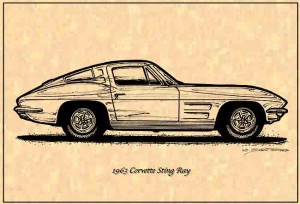
___________________________
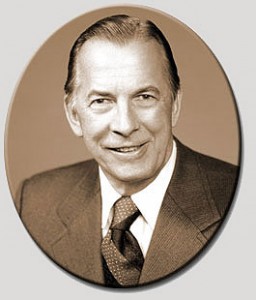 Caption – Lucky for us, but this “corporate man” had a passion for cars and let Duntov, the wild Russian, in the door. Chevrolet and GM has never been the same.
Caption – Lucky for us, but this “corporate man” had a passion for cars and let Duntov, the wild Russian, in the door. Chevrolet and GM has never been the same.
2. Ed Cole – For a long time, I’ve called the Corvette a “modern American automotive miracle.” In the ‘50s, corporate culture inside GM wasn’t much different than it is today – lots of arrogance and ego. The only way a low-volume car like a Corvette could survive in a major manufacturing company like General Motors was to have an angel – a champion to allow it to happen.
Cole was a very ambitious man and is credited with the design and development of the Cadillac V8-variant that we call, the small-block Chevy. Cole was a corporate man, but he liked fast cars and had an eye for talent. While it was Duntov that first approached GM, it was Cole that let Duntov in the door. Zora had never worked inside a major corporation the likes of GM. You could say that he was a brilliant misfit and were it not for his friend, Ed, he probably would have been tossed out early on. Yes, it’s good to have friends in high places.
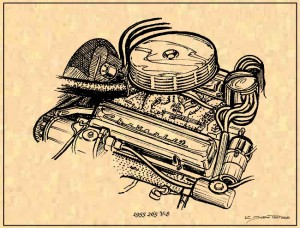
__________________________________________
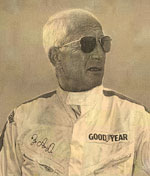 Caption – Does this guy look he fits in a corporate culture? After a few years, Duntov got pretty good at being a guerilla fighter with a white shirt and tie. But he was most comfortable behind the wheel of a prototype Corvette, wearing his driving suit.
Caption – Does this guy look he fits in a corporate culture? After a few years, Duntov got pretty good at being a guerilla fighter with a white shirt and tie. But he was most comfortable behind the wheel of a prototype Corvette, wearing his driving suit.
3. Zora Arkus-Duntov – I’m sure there were a few mutterings inside GM that asked, “Who let that guy in here?” It must have been a heady thing to be perhaps the only person inside GM that had actually raced cars. He certainly knew more about sports cars than anyone in GM, and possibly all of Detroit in 1953. You could say that Duntov was a passionate guy, and he liked beauty too. Just look at his stunningly beautiful wife, Elfie Duntov. Elfie had been a dancer in “The Bluebell Girls” a dancing troop with the famous Follies Bergere. When Elfie and Zora got to America, she was offered an audition by Jackie Gleason with his June Taylor Dancers. So Zora recognized beauty and he saw it in 1953 when he first eyed the Corvette at GM’s ‘53 Motorama Show.
Years later he was quoted as saying, “It was the most beautiful car I had ever seen.” The Corvette was clearly what motivated him to want to work for GM and make the Corvette into a REAL sports car. Duntov brought passion and a daredevil attitude to the Corvette effort that was totally out of step with the GM corporate way of life.
Heck, he even did his own test driving at what were then, insane speeds of 150-plus miles-per-hour. Were it not for Duntov’s relentless drive and passion, the Corvette would have been watered down into “something else,” not unlike Ford’s Thunderbird. However, it may surprise you to know that Duntov wasn’t crazy about the C2 Sting Ray or the Mako Shark-inspired C3 Corvette. And here’s the kicker – if Duntov had been in charge of the Corvette’s styling, the car would have looked more like a Porsche 550!
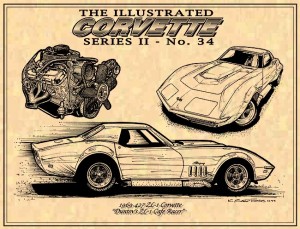
_____________________________________________
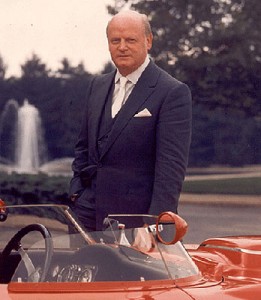 Caption: Some of Mitchell’s best quotes are, “I got gasoline in my veins!” and “I DESIGN Corvettes around here!” Yes SIR!
Caption: Some of Mitchell’s best quotes are, “I got gasoline in my veins!” and “I DESIGN Corvettes around here!” Yes SIR!
4. Bill Mitchell – Harley Earl was GM’s “prince of styling” and Bill Mitchell’s mentor. Mitchell had no background in automotive engineering, he was a commercial artist and illustrator that liked to draw fast cars. While working for an ad agency in the ‘30s, someone suggested that Bill show one of his car drawings to GM’s Chief of Styling, Harley Earl. Obviously, the rendering impressed Earl and the young Mitchell was offered a job in GM’s styling department. From there, he learned the automobile business by being in it and paying attention to “how” cars are designed and built. He was so sharp that when it was time for Harley Earl to retire, the position of Chief of GM Styling was given to the 46-year old Mitchell.
Having a self-professed passion for fast cars (he used to like to say, “I got gasoline in my veins!”) one of the first things Bill took on was a new style for the Corvette that would be a breakaway design from his mentor and be a reflection of his personal sense of style, flair, and pizzazz. The ‘63 Corvette Sting Ray is arguably his best design and probably what he will be remembered for in the automotive history books.
While Earl’s first Corvette is a classic and the later year C1 Corvettes have become icons of the ‘50s, Mitchell’s Sting Ray is sharp and looks like 100-mph sitting on a car showroom floor. (It sure seemed that way to me when I first saw one!) And if that’s not enough, Mitchell totally nailed down the all-time classic look of the Corvette with his Mako Shark II that was the foundation of the C3 Corvette. The curvaceous fender humps of the C3 have become trademarks of the Corvette style. Were it not for Bill Mitchell’s eye for aggressive, cutting-edge style, the Corvette would most likely have faded away like the Chevy Monza.
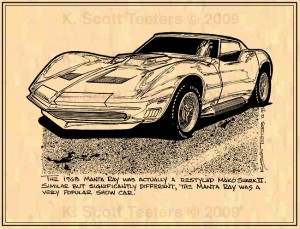
__________________________________________
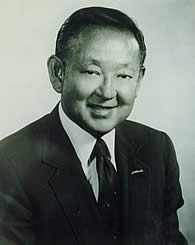 Caption – All-around good guy, Shinoda worked out the details of the C2 Sting Ray, the Corvair Monza GT, the XP-819 rear-engine Corvette prototype, the Boss 302 Mustang and many other classic ‘60s cars.
Caption – All-around good guy, Shinoda worked out the details of the C2 Sting Ray, the Corvair Monza GT, the XP-819 rear-engine Corvette prototype, the Boss 302 Mustang and many other classic ‘60s cars.
5. Larry Shinoda – I don’t want to present the above-mentioned men as having created and worked out every detail of the Corvette’s development. They were the “big picture” men, although Duntov had the most hand’s –on experience with the car. But even Zora had engineers to “work out the details” because frankly, often-times, he wasn’t good at the little stuff.
Similarly, Bill Mitchell didn’t work out all the details of the designs he is credited for, but he was the progenerator of the overall theme. As an executive, Mitchell had design assistants, the most prominent, and certainly not the only one, was Larry Shinoda. For instance, it was Mitchell that in ‘57 wanted the style of the proposed ‘60 Corvette to have the unique fender humps and a strong horizontal beltline.
The first version of this thinking can be seen on the ‘57 Q-Corvette. The details of that initial design effort were worked out under the guidance of Bob McLean by stylists Bob Veryzer and Pete Brock. The Q-Corvette never made it past a full-size clay mockup, but the shape was too hot to drop. When Mitchell wanted to go racing on his own dime with Duntov’s refurbished mule chassis from his aborted SS Corvette racer effort, Larry Shinoda was called upon to work out the styling details from the Q-Corvette for Mitchell’s ‘59 Stingray Racer.
With a little help from Duntov, Mitchell’s racer did rather well for itself, winning the SCCA C/Modified Championship in 1960. Shinoda worked so well with Mitchell, he became the lead stylist when it came time to make the Stingray Racer’s shape into a real car that could be manufactured. You could say that Shinoda hitched his cart to Mitchell’s wagon. But then again, Mitchell wasn’t about to work out nit-picky details of styling a production car. That was Shinoda’s job. The timeless beauty of the details on the ‘63 – ‘67 Corvette Sting Ray look perfect from any angle and secured Larry Shinoda’s place in Corvette history.
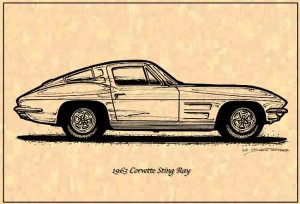
___________________________________________
So, there you have it, my Top Five list of key players in the Corvette story. I believe that had any of the above mentioned five men had not been part of the effort, we wouldn’t be here now talking about Corvettes. The conversation might have been more like, “Remember that Corvette that Chevy used make back in the ‘60s? Yea, cool car until they…” I think the duration and success of this car that GM normally never would have made (remember the Fiero), qualifies the Corvette as a Modern American Automotive Miracle. There have literally been thousands of people that have contributed to the Corvette legend – many we have heard and read about, but most we’ll never know. Regardless, thanks everyone!
Who have I missed that you feel contributed to the Corvette legend? What inside stories do you have to share about these masters?
Great Corvette Gift Ideas for the Corvette Enthusiast
C5 & C6 Corvette Leather Jackets, Luggage and Accessories
